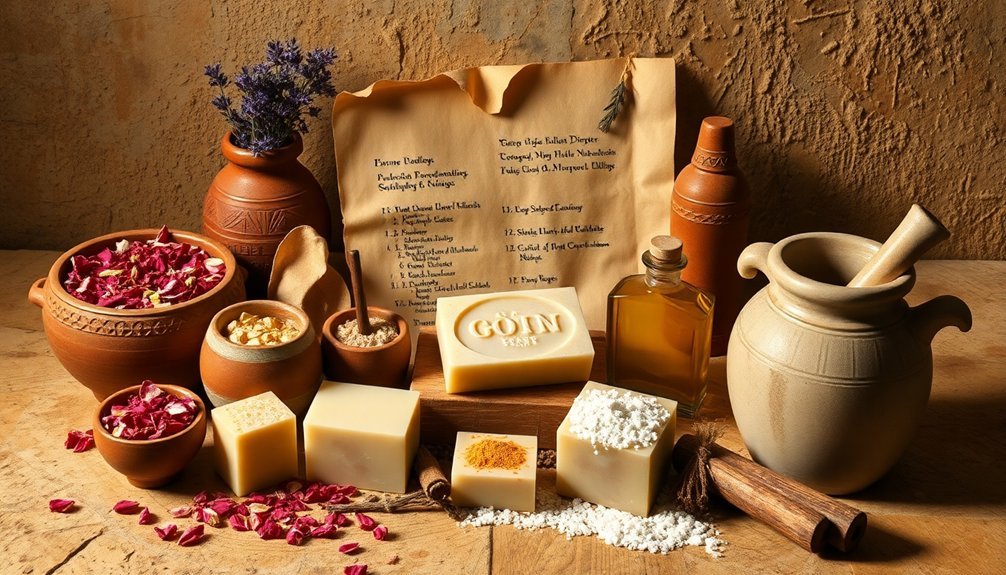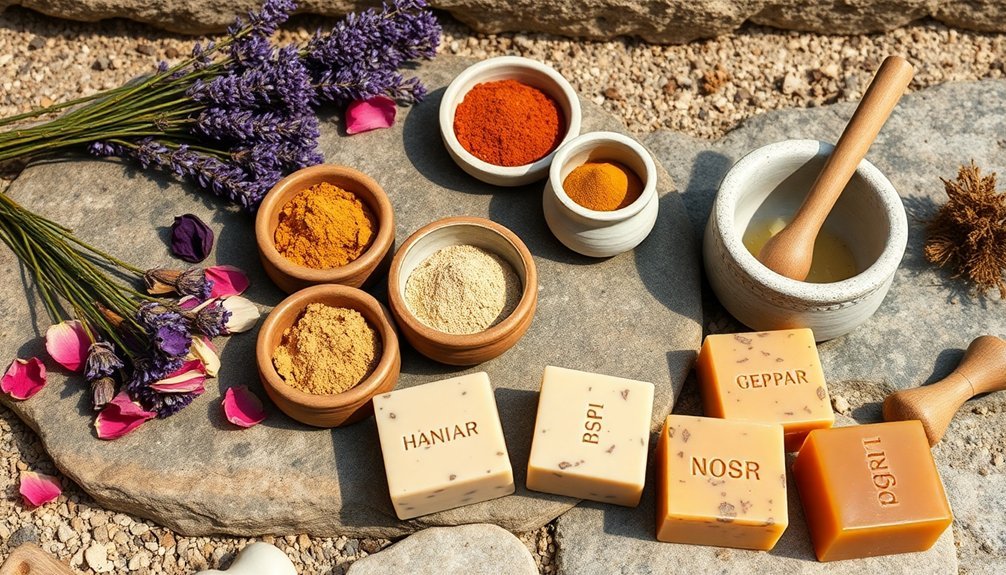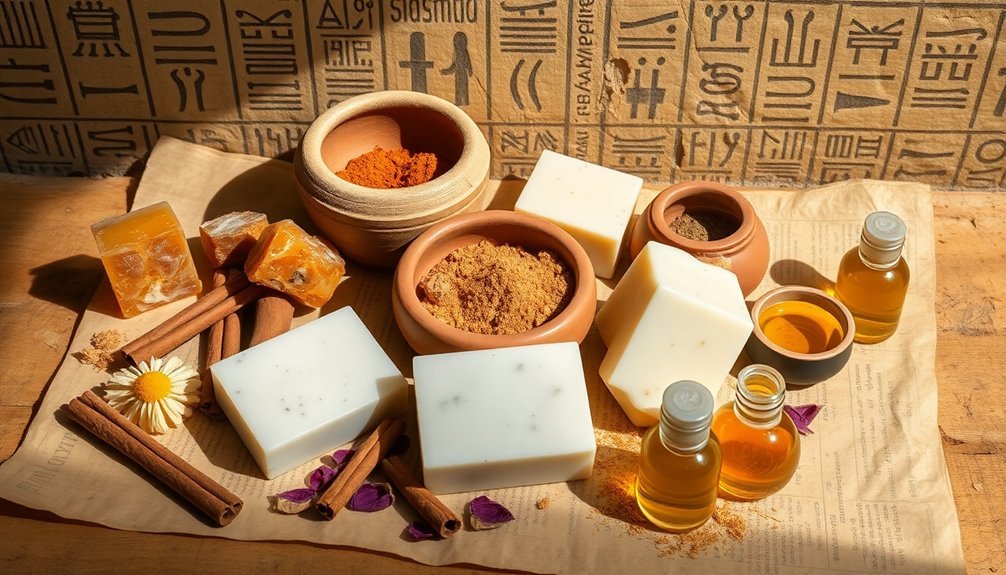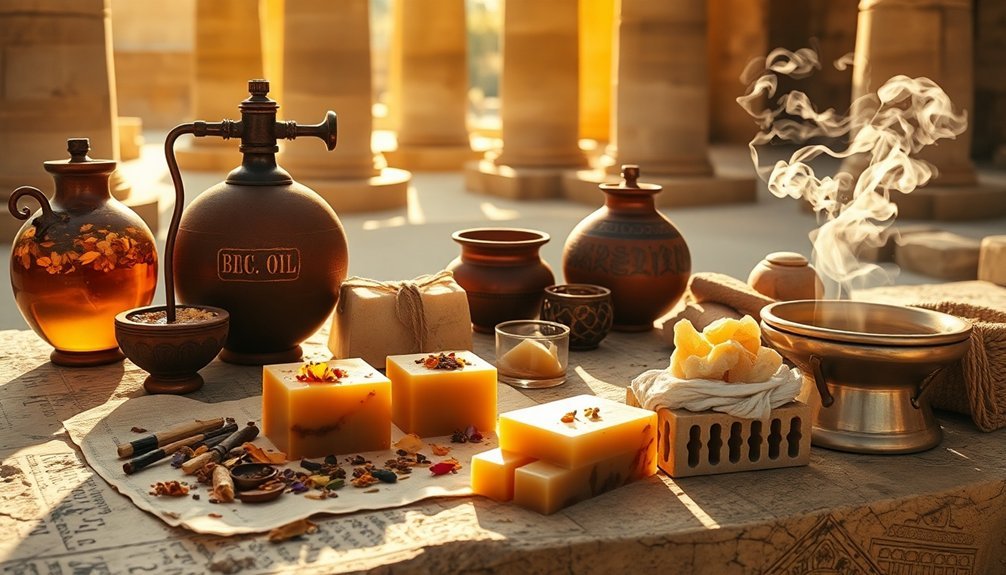Ancient soap perfuming dates back to Egyptian and Mesopotamian civilizations where natural botanicals, resins, and oils transformed cleansing into sacred rituals. You'll find that early artisans used techniques like infusion and distillation to extract fragrances from myrrh, frankincense, and sandalwood. These scented soaps weren't just for hygiene—they connected physical cleansing with spiritual purification. Trade routes later introduced exotic ingredients like cinnamon and jasmine, forever changing this sophisticated aromatic tradition.
Ancient Soap Perfuming: Lost Art of Fragrance

The ancient practice of perfuming soap represents one of humanity's earliest luxuries, blending functionality with sensory pleasure.
When you examine Egyptian and Roman bathing rituals, you'll discover they weren't merely about cleanliness but spiritual purification and social refinement.
Unlike today's synthetic scents, ancient fragrances came from nature's pharmacy—olive oils infused with herbs, flowers, and essential oils.
You'd find Egyptians incorporating these perfumed soaps into religious ceremonies, while Romans preferred scented ointments for their daily grooming.
The soap-making process itself was an art form, combining alkaline substances with fats before adding precious botanical extracts.
This meticulous craft has largely disappeared, replaced by mass production methods that prioritize cost over authenticity.
What you're missing is the rich, complex aromatics that once transformed cleanliness into a multisensory experience.
Origins of Scented Cleansing Rituals in Early Civilizations

Long before our modern shower gels and synthetic fragrances, ancient civilizations pioneered scented cleansing rituals that merged hygiene with spiritual practice.
In ancient Egyptian society, people combined clay with aromatic oils since soap hadn't yet been invented. They'd extract scents from plants and resins to elevate their bathing experience beyond mere cleanliness.
Similarly, India's traditions incorporated herbal oils and fragrant powders following Ayurvedic principles that connected scent with overall wellness.
Romans preferred ointments infused with lavender and roses rather than what we'd recognize as soap today.
You'll find that these early scented rituals weren't just practical—they served important social and ceremonial functions, reflecting each culture's values and spiritual beliefs in ways that transcended simple cleanliness.
Natural Botanical Sources Used in Ancient Soap Fragrance

Natural botanicals formed the aromatic foundation of ancient soap creation, transforming basic cleansing agents into sensory experiences.
You'd find Egyptians masterfully blending myrrh and frankincense oils into their soaps, which not only provided luxurious scents but also extended shelf life through their natural preservative qualities.
Romans elevated fragrance to signify social status, incorporating olive oil with local herbs to create distinctive aromas. The therapeutic properties of lavender and rosemary made them particularly sought-after natural ingredients across many ancient cultures.
In India, sandalwood played a central role in soap production, connecting daily hygiene with Ayurvedic traditions.
These ancient perfuming techniques weren't merely aesthetic choices—they represented sophisticated understanding of plant properties and their effects on both body and spirit, creating cleansing rituals that engaged multiple senses.
Resins and Aromatics in Egyptian and Mesopotamian Soaps

Deeply embedded in ancient societies' spiritual and medicinal practices, resins and aromatics transformed Egyptian and Mesopotamian soaps from simple cleansing agents into multi-sensory experiences.
You'll find evidence of myrrh and frankincense in Egyptian soap formulations, where these fragrant resins enhanced cleansing properties while connecting daily hygiene to spiritual purification.
Mesopotamian clay tablets reveal sophisticated recipes blending fats and alkaline substances with spices and aromatic plants.
These weren't merely practical innovations—they reflected the profound cultural significance of scent in ancient life.
When you examine archaeological findings, you'll notice that both civilizations understood the power of fragrance in elevating routine washing into ritualistic experiences.
The resins and aromatics they carefully selected served dual purposes: cleansing the body while simultaneously purifying the spirit through their divine scents.
The Sacred Role of Fragrance in Cleansing Ceremonies

Across ancient civilizations, you'd find ritual purification protocols that required specific fragrances to cleanse both body and spirit before approaching the divine.
Each deity demanded unique cleansing methods, with priests selecting particular scented oils, resins, and aromatics believed to please specific gods or goddesses.
Temple bathing ceremonies further elevated these practices, transforming simple hygiene into sacred experiences where fragrance served as the invisible bridge between the mortal and divine domains.
Ritual Purification Protocols
While modern perfumery focuses primarily on aesthetic appeal, ancient civilizations viewed fragrance as a sacred bridge between physical cleanliness and spiritual purity.
Ritual purification protocols followed precise formulations, combining clay with essential oils to cleanse both body and spirit before divine encounters.
You'd find Egyptian priests meticulously preparing frankincense and myrrh to create the proper atmosphere for communion with deities.
The Latin origin of "perfume" – "through smoke" – reveals how these aromatic substances were often burned during ceremonies, releasing scents believed to ward off malevolent forces and illness.
These weren't merely pleasant fragrances but powerful spiritual tools.
In Rome and Egypt, you couldn't enter sacred spaces without first undergoing scented purification, as cleanliness signified worthiness to approach the gods.
These careful protocols transformed ordinary cleansing into profound spiritual experiences.
Deity-Specific Cleansing Methods
Ancient civilizations recognized that each deity demanded unique olfactory offerings, resulting in meticulous fragrance protocols that varied by divine recipient. You'd find Egyptian priests engaged in fragrance creation specifically tailored to honor their pantheon during purification ceremonies.
| Deity | Associated Scents | Cleansing Purpose |
|---|---|---|
| Hathor | Myrrh, Sandalwood | Blessing invocation |
| Isis | Frankincense, Rose | Spiritual purification |
| Osiris | Cedar, Juniper | Death ritual cleansing |
When participating in these sacred rituals, you'd anoint yourself with oils corresponding to the deity you're honoring. The aromatic smoke from these scented substances wasn't merely pleasant—it served as a divine communication channel. Priests believed these specific fragrances could ward off negative energies while purifying both body and sacred spaces, demonstrating how intricately scent and spirituality intertwined in ancient cleansing practices.
Temple Bathing Ceremonies
Temple bathing ceremonies elevated the ordinary act of cleansing into a profound spiritual experience through deliberate fragrance selection.
You'd find ancient worshippers immersed in rituals where fragrant oils and resins served dual purposes—purifying both body and soul.
In Egyptian tradition, you couldn't approach the divine without proper scented preparation, as cleanliness was essential for afterlife passage.
Priests carefully selected aromatic substances like myrrh and frankincense, believing these precious materials attracted divine favor during temple bathing ceremonies.
The application of perfumed ointments transformed hygienic necessity into sacred communion.
When you understand the cultural significance of these practices, you'll recognize how ancient societies viewed scent as more than pleasant—it was the invisible bridge connecting human and divine spheres, embodying concepts of purity, healing, and spiritual transformation.
Techniques for Infusing Oils With Herbal Essences
Craftsmen from antiquity discovered that infusing oils with herbal essences required patience and precision to capture nature's aromatic treasures. You'll find two primary methods they mastered: cold infusion, which preserves delicate compounds through extended steeping, and hot infusion, which accelerates extraction using gentle heat.
Your choice of carrier oil determines the final fragrance profile. Olive oil was particularly prized for its stability and complementary notes.
| Method | Carrier Oil | Duration | Storage | Best For |
|---|---|---|---|---|
| Cold | Olive | 2-6 weeks | Dark glass | Delicate herbs |
| Hot | Jojoba | 2-4 hours | Amber bottle | Woody herbs |
| Solar | Almond | 1-2 weeks | Sealed jar | Flowering plants |
| Double-boiler | Coconut | 30-60 min | Cool cabinet | Roots & barks |
| Essential blend | Apricot | Immediate | Refrigeration | Quick results |
Roman Innovations in Soap Perfuming Methods
The Romans revolutionized perfuming techniques by elevating simple cleansing agents into aromatic luxuries that served both practical and symbolic purposes. You'd find their pioneering distillation processes extracted essential oils from flowers and herbs, creating the foundational methods still reflected in modern perfumes.
Unlike their predecessors, Romans prioritized scent over cleansing power, incorporating lavender, roses, and pomegranates into their daily bathing rituals. If you were wealthy, you'd enjoy exotic fragrances like myrrh and cinnamon, displaying your status through scent alone.
The Romans' artistic sensibility extended to their perfumed products' presentation, housing these aromatic blends in decorative glass, bronze, or precious metal containers.
This integration of fragrance into daily hygiene practices established perfuming traditions that would influence soap making for centuries to come.
Forgotten Extraction Methods of Ancient Perfumers
Ancient perfumers mastered techniques you'd barely recognize today, including enfleurage where fragrant flowers were pressed into fat to extract their essential oils.
You'll find evidence of clay distillation vessels that predated glass apparatus, offering a primitive but effective method for capturing volatile compounds before modern distillation emerged.
Cold-pressed flower essences represented another forgotten art, where gentle pressure extracted delicate fragrances without heat, preserving subtle notes that would otherwise be lost through thermal processing.
Empressing With Enfleurage
Long before modern perfumery embraced technological extraction methods, delicate enfleurage techniques captured the soul of flowers through patient artistry.
You'd recognize this method by its distinctive approach: placing fresh blossoms in fat that gradually absorbed their essence without heat's destructive influence.
Both ancient Egyptians and Indians mastered enfleurage, creating exquisite perfumes from jasmine and roses.
You're looking at a labor-intensive process—the same fat required multiple flower replacements to achieve the desired fragrance concentration.
Historians like Theophrastus and Pliny the Elder documented this meticulous practice in their texts, preserving knowledge of this significant technique.
Though modern distillation has largely supplanted enfleurage, artisanal perfumers still honor this ancient method for its unparalleled ability to extract pure, rich scents from nature's most delicate blooms.
Clay Distillation Techniques
Three distinct advantages made clay distillation a revolutionary technique for early perfumers seeking to capture nature's most elusive scents.
The porous structure of clay vessels allowed for better retention of volatile compounds that might otherwise escape during the heating process.
You'll find evidence of these methods in ancient Egypt and India, where perfumers mastered the art of extracting concentrated oils from plants.
Cold-Pressed Flower Essences
While clay distillation captured heat-friendly scents, another technique flourished alongside it in the workshops of ancient perfumers.
Cold-pressed flower essences represented the pinnacle of delicate fragrance preservation. You'll find this technique documented in Egyptian and Indian texts, where perfumers meticulously extracted oils without heat to maintain their chemical integrity.
By mechanically pressing flowers, they released pure essences that couldn't survive thermal processes.
These cold-pressed flower essences served multiple purposes – from luxurious perfumes to therapeutic applications. The method proved especially effective for delicate botanicals like jasmine and citrus peels, whose subtle compounds would otherwise degrade.
Today's perfumery industry is rediscovering these ancient extraction methods, recognizing their value in producing authentic, natural fragrances.
This revival reflects our growing appreciation for traditional practices that honor both the botanicals and the wisdom of ancient perfumers.
Cultural Significance of Scent Profiles Across Ancient Societies
Although modern society often views perfume as merely a luxury, ancient civilizations integrated fragrance into every aspect of their cultural identity. In Egypt, scents like myrrh weren't just for personal adornment—they connected worshippers to deities through ritualistic offerings.
These ancient perfumes transcended social class, particularly in Rome, where fragrant ointments became accessible to citizens across economic strata.
You'll find that across diverse societies, from India's Gandhavans working with sandalwood to Cleopatra's innovation of perfumed sails, scent profiles weren't merely aesthetic choices but expressions of spiritual devotion and markers of identity.
Complex recipes documented in ancient texts reveal how fragrance formulations carried therapeutic intentions alongside social significance.
What's particularly fascinating is how these civilizations understood something we're only rediscovering today: scent's power to transform both individual experience and communal identity.
Archaeological Evidence of Perfumed Soap Production
Beneath layers of ancient soil and forgotten settlements, archaeologists have uncovered compelling evidence of perfumed soap production dating back to 2800 BCE in Mesopotamia.
These discoveries reveal soap-making techniques involving fat mixtures with alkaline salts, often enhanced with aromatic oils and fragrant resins from local plants.
You'll find similar evidence in Pompeii, where excavations revealed soap-like substances combined with aromatic oils, indicating Romans valued scented cleansing products.
Ancient Egyptian sites have yielded specialized soap molds and perfume containers, demonstrating the sophisticated integration of fragrance into daily hygiene rituals.
Pliny the Elder's texts further document these practices, confirming what physical evidence suggests: ancient civilizations understood and valued the combination of cleanliness and pleasant aromas as essential components of personal care and social presentation.
Tools and Vessels for Ancient Soap Fragrance Creation
You'll find that ancient soap perfumers used specialized vessels like alabaster jars and bronze containers to preserve their precious fragrances.
These artisans relied on stone mortars and pestles to grind aromatic ingredients, creating the perfect blend of scents for their soap creations.
The detailed carvings and motifs adorning these vessels weren't just decorative but symbolized the cultural significance of fragrance in ancient daily life.
Specialized Fragrance Vessels
Numerous specialized vessels played an essential role in ancient soap perfuming, reflecting both artistic achievement and practical necessity. You'd find alabastrons in Egyptian households, carefully crafted to preserve precious oils used in soap-making. Romans preferred ornate containers that not only stored their scented ointments but also displayed their social status.
| Culture | Vessel Type | Materials |
|---|---|---|
| Egyptian | Alabastrons | Alabaster, stone |
| Roman | Ornate bottles | Glass, precious metals |
| Greek | Figurative vessels | Clay, ceramic |
These specialized vessels weren't merely functional—their intricate designs, often shaped as doves or women's heads, signified wealth and refinement. The containers were engineered specifically to maintain the aromatic properties of their contents, showcasing how ancient civilizations valued both fragrance preservation and aesthetic appeal.
Artisanal Blending Implements
Ancient perfumers relied on a remarkable array of artisanal implements to create their fragrant soap blends, each tool serving a specific purpose in the complex production process.
At the heart of their craft were mortars and pestles, essential for grinding aromatic herbs, spices, and resins into fine powders that would release their fragrant compounds effectively.
You'll find that these craftspeople often stored their precious oils in alabaster jars, prized for their non-porous nature that preserved the integrity of delicate scents.
These containers worked alongside specialized mixing vessels designed specifically for techniques like enfleurage and maceration.
The perfumer's workbench typically featured a collection of measuring implements and blending tools that allowed for precise formulation according to closely guarded recipes, reflecting their status as respected artisans in ancient society.
The Influence of Trade Routes on Soap Scenting Ingredients
While local plants provided basic fragrances for early soaps, trade routes transformed the ancient art of soap perfuming by introducing exotic scents from distant lands.
The establishment of the Silk Road brought cinnamon and clove, which craftsmen incorporated into their scented creations. You'd find these expensive perfume ingredients only in the homes of the wealthy.
Maritime trade with the Arabian Peninsula and India introduced jasmine and sandalwood, adding floral complexity to ancient soap formulations.
Roman conquests further expanded access to aromatic substances, with myrrh and frankincense becoming prized additions through Mediterranean and Middle Eastern trade networks.
The status of individuals was often reflected in their bathing products—the more distant the origin of the scent, the more prestigious the soap.
Lost Formulas: Recreating Ancient Soap Fragrances Today
How does one recapture the exact scent profile of a 2,000-year-old Roman soap? Modern artisans blend archaeological evidence with historical texts like Pliny the Elder's writings to reconstruct these forgotten formulas.
You'll find contemporary soap makers using cold pressing and boiling methods similar to ancient techniques, carefully infusing available ingredients such as olive oil, myrrh, cinnamon, and rosemary.
These natural components mirror those traded along ancient Mediterranean routes, though today's recreations must sometimes substitute rare or extinct botanicals.
The challenge lies in balancing historical authenticity with contemporary standards. While modern perfumers can't perfectly replicate what Romans experienced, they can capture the therapeutic essence of these ancient cleansers—creating soaps that honor traditional fragrancing while meeting today's expectations for performance and scent.
Frequently Asked Questions
Why Does Bar Soap Lose Its Scent?
Your bar soap loses its scent because fragrance compounds evaporate when exposed to air and light. The soap's pH, moisture, and saponification process also break down scents, especially in soaps with natural ingredients.
Does Old Perfume Lose Its Scent?
Yes, your old perfume will lose its scent over time. It's exposed to light, heat, and air, causing chemical changes in the fragrance compounds. Most perfumes last 3-5 years before noticeably fading.
Why Has My Perfume Lost Its Smell?
Your perfume's lost its smell due to exposure to light, heat, or air. It might be past its 3-5 year shelf life, or you've stored it improperly. Natural fragrances deteriorate faster than synthetic ones.
What Is the Rarest Scent in the World?
You'll find that oud from agarwood trees is often considered the world's rarest scent. Ambergris from sperm whales, Tom Ford's Black Orchid, and Jasmine Grandiflorum are also extraordinarily rare and valuable fragrances.
In Summary
You've glimpsed a forgotten world where fragrance wasn't just an afterthought, but the soul of cleansing rituals. While ancient perfumed soap formulas remain largely lost to time, you're now part of their rediscovery. By understanding these ancestral techniques, you're connecting to centuries of aromatic wisdom. Today's soap crafters aren't just making products—they're reviving an art that once linked humanity to the divine through scent.





Leave a Reply